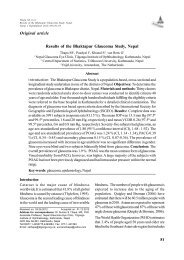nepjoph 2012.pmd - Nepalese Journal of Ophthalmology
nepjoph 2012.pmd - Nepalese Journal of Ophthalmology
nepjoph 2012.pmd - Nepalese Journal of Ophthalmology
Create successful ePaper yourself
Turn your PDF publications into a flip-book with our unique Google optimized e-Paper software.
Ganekal S<br />
Ganglion cell complex scan<br />
Nepal J Ophthalmol 2012;4(8):236-241<br />
Table 2<br />
GCC vs RNFL thickness<br />
Group RNFL thickness Superior Inferior GCC thickness<br />
Glaucoma suspects 112.41 ± 10.92 110.42 ± 9.91 114.38 ± 13.61 95.40 ± 8.11<br />
Glaucoma patients 98.57 ± 13.68 100.45 ± 16.35 98.49 ± 15.79 86.06 ± 12.43<br />
Discussion<br />
Although glaucoma is clinically defined as optic disc<br />
cupping with corresponding visual field defects, the<br />
underlying disease process in glaucoma is the loss<br />
<strong>of</strong> RGC (Quigley HA et al1989: Quigley HA et<br />
al1980: Sommer A et al 1977). Approximately onethird<br />
<strong>of</strong> the RGC population resides within the<br />
posterior pole. In the macula, the RGC layer is more<br />
than one cell layer thick with the RGC body diameter<br />
being 10 to 20 times larger when compared to their<br />
axons. In addition, the central retina has less<br />
variability in cell density when compared to the<br />
peripheral retina (Glovinsky Y et al 1993). Thus, in<br />
some cases detecting RGC loss in the macula may<br />
allow for earlier detection <strong>of</strong> glaucoma.<br />
The higher resolution RTVue system allows for more<br />
specific segmentation by allowing only the retinal<br />
layers associated with the ganglion cells to be<br />
analyzed. This method <strong>of</strong> segmenting out the<br />
ganglion cell complex targets the layers directly<br />
associated with the ganglion cells, whereas the<br />
stratus method can only analyze the entire retinal<br />
thickness.<br />
In the past, most investigators have focused on<br />
comparing the measurements <strong>of</strong> the macula and the<br />
optic disc. At the time, most commercial imaging<br />
instruments yielded measurements <strong>of</strong> only one or<br />
the other. Now, many techniques are available for<br />
obtaining both measurements in one session. The<br />
perifoveal region yields information on the ganglion<br />
cells and their axons located at the centre <strong>of</strong> the<br />
macula, which are represented in perimetry by only<br />
a few points at the centre <strong>of</strong> the visual field, whereas<br />
the peripapillary region reflects the entire retina. The<br />
time course <strong>of</strong> the disease and treatment decisions<br />
may differ between eyes with a well-preserved<br />
central macula and damaged peripheral retina, and<br />
one with damage to both areas. By including both<br />
regions, it may be possible to gain new knowledge<br />
on the process <strong>of</strong> glaucomatous damage through<br />
an additional role for measuring GCC in glaucoma<br />
assessment.<br />
Ishikawa H et al (2000) developed a s<strong>of</strong>tware<br />
algorithm to perform automatic retinal layer<br />
segmentation in the macula for the commercially<br />
available Stratus TD-OCT and reported that<br />
macular inner retinal layer thickness measurements<br />
could indeed be used to discriminate normal from<br />
glaucomatous eyes. They found that the outer retinal<br />
layers were not affected in glaucoma. However, one<br />
<strong>of</strong> the limitations <strong>of</strong> the study was variable scan<br />
quality. Over one-third <strong>of</strong> the scans on glaucomatous<br />
eyes had to be excluded from segmentation analysis<br />
due to poor quality scans related to speckle noise<br />
and uneven tissue reflectivity. The authors suggested<br />
that higher resolution and improved signal quality<br />
(higher signal-to-noise ratio), as provided by FD-<br />
OCT, may be needed for better quality image<br />
acquisition to allow accurate retinal layer<br />
segmentation.<br />
Greenfield et al (2003) reported that OCT-derived<br />
macular thickness was well correlated with changes<br />
in visual function and RNFL structure in moderately<br />
advanced glaucoma. They reported a strong<br />
correlation between mean macular thickness and<br />
visual field mean deviation (R 2 =0.47, p




